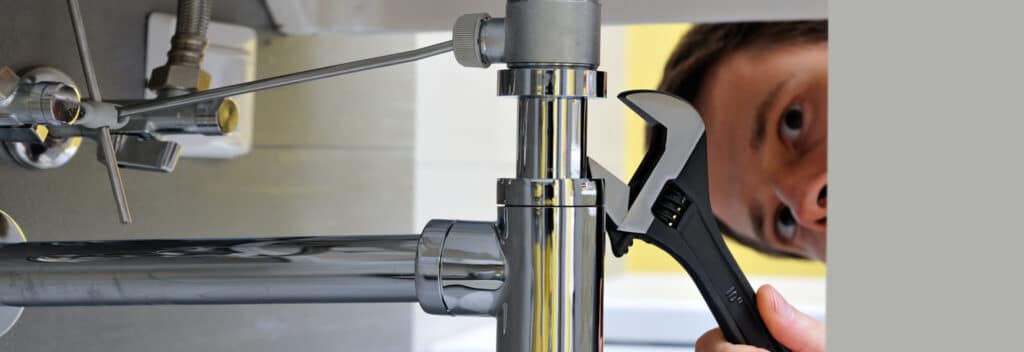According to the Government of Canada, the average Canadian uses about 220 litres of water per day . We use it in the bathroom for flushing and bathing, for cleaning, drinking and prepping food and for laundry. When the water pressure decreases in your home, it compromises the efficiency and enjoyment of all these tasks – unless of course you like standing awkwardly in the bathroom waiting for what seems like forever for the toilet tank to fill.
There’s no one-size-fits-all solution for low water pressure. Lower water pressure can be caused by a number of different things, and figuring out which issue is the culprit in your home will determine your next steps. Some are easy fixes; others require a bit more elbow grease and a few bucks.
First Things First
The most important question to ask is: Do I have low water pressure in all my plumbing fixtures or just in one? If your whole home seems plagued by sluggish pressure, the source of the problem is almost certainly your water supply or pipes. Text a neighbour to find out if they’re experiencing the same. If they are, the problem is likely not within your home. Your municipal water supplier could be upgrading infrastructure or have an issue with their water supply.
If you can’t get the water flowing in one particular room or device, it’s safe to assume the low pressure is a result of a damaged localized pipe or plumbing fixture and it’s time to focus on that specific area.
Water Valves
The Problem:
Recently renovated your home, updated your plumbing or experienced a burst pipe? You may have had to turn off your home’s main water valve or the city may have turned off the valve connecting your home to the city water line. When the crisis was resolved, it’s possible you or the city didn’t rotate the valves completely back to the on position, causing a lower water pressure throughout your home.
The Solution:
I know. You wish you’d thought of this. It’s OK. Go and check now. (Note: You may be able to access only your home’s water valve.) Make sure the valves are twisted all the way into the open position. Once you have opened the valve all the way close it slightly (1/8 to ¼ of a turn) to help prevent the valve from sticking. Water valves come in all shapes and sizes, so make sure you’re comfortable operating your particular valves before you start, or contact a Reliance® plumbing professional for support.
Pressure Regulator
The Problem:
Although a super-strong-and-steady stream of water coming out of all of your faucets sounds like winning the water-pressure lottery, too much pressure can actually damage your plumbing infrastructure and lead to water wastage. Which brings us to pressure regulators. If the water pressure coming inside from the city water line is too intense, your home may have a pressure regulator. This is a good thing — until the control valve starts to conk out. A failing pressure regulator can cause a sudden spike in water pressure, but it can also lead to an immediate lower water pressure, affecting all the plumbing in your home.
The Solution:
Repairing or replacing a pressure regulator can be tricky business. Because this valve serves such an important purpose and the risk of damage to your home is high, it’s best to book an appointment with a Reliance plumbing professional to make sure it’s done right.
Pipe Problems
The Problem:
Pipes get old the same way our veins do. They can get leaky, corroded, cracked and clogged. Yay aging! The material type(s) of your pipes, the time of their installation and the landscape environment surrounding your home factor into the integrity of your piping infrastructure. Galvanized steel, for example, was for many years the pipe material of choice, but we know now it’s prone to mineral deposits, corrosion and other debris, eventually causing clogs. If when you turn on your faucet, the water runs normally but then slows, clogged galvanized pipes may be the problem.
One doozie that many homeowners don’t think of when contemplating their water pressure woes is that their property may share a water line (and therefore water pressure) with a neighbouring home. So if Nosy Neighbour Nancy tends to take endless showers and waters her grass incessantly, you may have a neighbour problem more than a water-pressure problem.
The Solution:
Instead of pouring toxic cleansers down your pipes and contaminating the water supply or yanking out all your plumbing to find the source of a single clogged or leaky pipe, book an appointment with a Reliance plumbing professional. We’ll get to the source of the problem and explain all the possible solutions. Visit our Plumbing pages to find more solutions.
(Sorry, we can’t help you with Nosy Neighbour Nancy. Good luck.)
Faulty Fixtures
The Problem:
If the water pressure seems weak in just one plumbing device, you’ve got an isolated issue. And although standing under the shower head without enough water pressure to rinse the conditioner out may seem like the end of the world at the time (“Calgon, take me away!”), remember that a localized problem is better than a whole-house one. In certain shower heads, for example, the aerator, which reduces the volume of water but doesn’t zap the pressure, can become rusty or clogged with mineral deposits or dirt. Alternatively, lower water pressure could be caused by a single aging, defective or damaged plumbing device.
The Solution:
If the faucet aerator is causing the kafuffle, simply remove and wash it thoroughly before replacing it. Test the water pressure. If that doesn’t improve things, the issue could be with the faucet as a whole and it may need to be replaced. Ditto for your other plumbing devices. A Reliance expert can help you determine what’s worth saving and what needs to be upgraded or replaced.
Get it fixed fast.
Book your plumbing repairs today.








